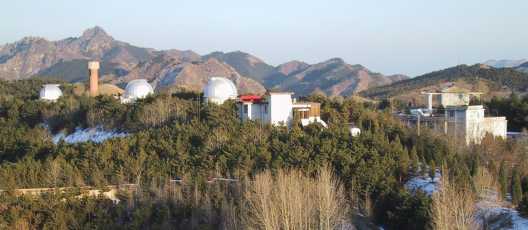Beijing Schmidt CCD Asteroid Program on:
[Wikipedia]
[Google]
[Amazon]
 The Beijing Schmidt CCD Asteroid Program (SCAP) was an
The Beijing Schmidt CCD Asteroid Program (SCAP) was an
WELCOME TO Xinglong Station of NAOC
webpage for the station where SCAP was conducted. It also shows a picture of the Schmidt telescope that SCAP used in its research.
BAO ASTEROID OBSERVATIONS: From Astrometry To Physical Researcj
– a Space.com special report by Michael Paine on the search for near-Earth asteroids
- a Beijing Review article by Li Rongxia on asteroid 7800
– a Spacedaily.com article by Wei Long on the Purple Mountain Observatory. The SCAP is briefly mentioned here.
describes the groups involved with asteroid detection. SCAP is briefly mentioned here. {{Planetary defense Chinese Academy of Sciences Astronomical discoveries by institution * Infrared telescopes Minor-planet discovering observatories Near-Earth object tracking Space telescopes
 The Beijing Schmidt CCD Asteroid Program (SCAP) was an
The Beijing Schmidt CCD Asteroid Program (SCAP) was an astronomical survey
An astronomical survey is a general map or image of a region of the sky (or of the whole sky) that lacks a specific observational target. Alternatively, an astronomical survey may comprise a set of images, spectra, or other observations of obje ...
to search for near-Earth objects
A near-Earth object (NEO) is any small Solar System body whose orbit brings it into proximity with Earth. By convention, a Solar System body is a NEO if its closest approach to the Sun (perihelion) is less than 1.3 astronomical units (AU). ...
. It was conducted during the 1990s, at the Xinglong Station in Xinglong County
Xinglong County () is a county in the northeast of Hebei province, bordering the Direct-controlled municipalities of the People's Republic of China, municipalities of Beijing to the west and Tianjin to the southwest. It is under the administration ...
, Chengde
Chengde, formerly known as Jehol and Rehe, is a prefecture-level city in Hebei province, situated about 225 km northeast of Beijing. It is best known as the site of the Mountain Resort, a vast imperial garden and palace formerly used by t ...
, Hebei
Hebei or , (; alternately Hopeh) is a northern province of China. Hebei is China's sixth most populous province, with over 75 million people. Shijiazhuang is the capital city. The province is 96% Han Chinese, 3% Manchu, 0.8% Hui, an ...
province, China and resulted in the discovery of more than a thousand numbered minor planet
According to the International Astronomical Union (IAU), a minor planet is an astronomical object in direct orbit around the Sun that is exclusively classified as neither a planet nor a comet. Before 2006, the IAU officially used the term ''minor ...
s.
Funded by the Chinese Academy of Science
The Chinese Academy of Sciences (CAS); ), known by Academia Sinica in English until the 1980s, is the national academy of the People's Republic of China for natural sciences. It has historical origins in the Academia Sinica during the Republic ...
, the survey is sometimes also called BAO Schmidt CCD Asteroid Program and NAOC Schmidt CCD Asteroid Program, referring to the Beijing Astronomical Observatory
Beijing Astronomical Observatory (BAO) is an observatory located around 150 kilometres northeast of Beijing, China. It was founded in 1958 and is part of the Chinese Academy of Sciences
The Chinese Academy of Sciences (CAS); ), known by Ac ...
(BAO) and National Astronomical Observatory of China
The National Astronomical Observatories, Chinese Academy of Sciences (NAOC, ) is an astronomical research institute operated by Chinese Academy of Sciences, along with Shanghai Astronomical Observatory, Purple Mountain Observatory and National Tim ...
(NAOC), respectively.
The instrument that SCAP used to detect near-Earth objects was a 60/90 cm Schmidt telescope
Schmidt may refer to:
* Schmidt (surname), including list of people with the surname
* Schmidt (singer) (born 1990), German pop and jazz singer
* Schmidt (lunar crater), a small lunar impact crater
* Schmidt (Martian crater), a crater on Mars
* ...
. Equipped with a 2048×2048 CCD camera, this telescope was installed at the BAO Xinglong station in Hebei province, China.
In a conversation with Space.com contributor Michael Paine, SCAP head Jin Zhu said that the program's allotted time to use the Schmidt telescope was significantly reduced to make room for the observatory's other projects.
Discoveries
From 1995 to 1999, SCAP detected one new comet and 2460 new asteroids and observed 43860 other asteroids, making it the fifth largest asteroid observation project at that time. Five of the asteroids it discovered were NEAs, two of which were consideredpotentially hazardous asteroid
A potentially hazardous object (PHO) is a near-Earth object – either an asteroid or a comet – with an orbit that can make close approaches to the Earth and is large enough to cause significant regional damage in the event of impact. They are ...
s (PHAs). In 2002, an NEA was discovered near Earth's moon
The Moon is Earth's only natural satellite. It is the fifth largest satellite in the Solar System and the largest and most massive relative to its parent planet, with a diameter about one-quarter that of Earth (comparable to the width of ...
.
Notable objects
List of discovered minor planets
See also
*References
External links
WELCOME TO Xinglong Station of NAOC
webpage for the station where SCAP was conducted. It also shows a picture of the Schmidt telescope that SCAP used in its research.
BAO ASTEROID OBSERVATIONS: From Astrometry To Physical Researcj
– a Space.com special report by Michael Paine on the search for near-Earth asteroids
- a Beijing Review article by Li Rongxia on asteroid 7800
– a Spacedaily.com article by Wei Long on the Purple Mountain Observatory. The SCAP is briefly mentioned here.
describes the groups involved with asteroid detection. SCAP is briefly mentioned here. {{Planetary defense Chinese Academy of Sciences Astronomical discoveries by institution * Infrared telescopes Minor-planet discovering observatories Near-Earth object tracking Space telescopes